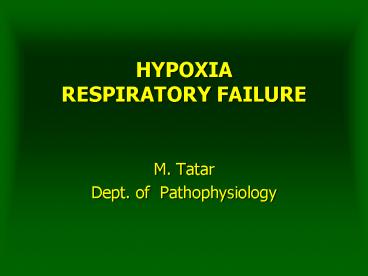HYPOXIA RESPIRATORY FAILURE - PowerPoint PPT Presentation
1 / 21
Title:
HYPOXIA RESPIRATORY FAILURE
Description:
HYPOXIA RESPIRATORY FAILURE M. Tatar Dept. of Pathophysiology HYPOXIA hypoxemia anoxia ischemia The aim of oxygen transport to preserve high PO2 gradient between ... – PowerPoint PPT presentation
Number of Views:1013
Avg rating:3.0/5.0
Title: HYPOXIA RESPIRATORY FAILURE
1
HYPOXIARESPIRATORY FAILURE
- M. Tatar
- Dept. of Pathophysiology
2
HYPOXIAhypoxemia anoxia ischemia
3
glucose
38 ATP
Krebss cycle
O2
CO2
H2O
glucose
2 ATP
pyruvate
lactate
4
The aim of oxygen transport
- to preserve high PO2 gradient between
capillaries and mitochondria
Q x Hb conc. x (SaO2 SvO2)
O2
c
circulation
respiration
ADP
Hb afinity to O2
microcirculation
erythropoiesis
VO2
m
5
Classification of hypoxia (1)
- Hypotonic hypoxemic hypoxia
- - ? PaO2, ? CaO2 Q . Hb . (? SaO2 SvO2)
- - carotid body stimulation, hyperventilation
- - pulmonary hypertension in chronic form
- - respiratory failure
- 2. Izotonic hypoxemic hypoxia
- - normal PaO2, ? CaO2 Q . ? Hb . (? SaO2
SvO2) - - chemoreceptors are not stimulated, lack of
dyspnea - - anemia, carboxyhemoglobin
6
Hb concentration and CaO2 interrelationship
300
100
polycythemia Hb 20
200
100
normal Hb 15
CaO2, ml/l
150
SaO2,
100
anemia Hb 10
20 60 100 120
PaO2 , mmHg
7
Classification of hypoxia (2)
- 3. Hypoextractive hypoxia
- - increased Hb afinity to O2
- - Q . Hb . (SaO2 ? SvO2)
100
released O2
SaO2,
50
pH 7,4 t 37 C
pH ? 7,4 t ? 37 C
6 14
PaO2, kPa
8
Classification of hypoxia 3
- 4. Hypocirculatory hypoxia
- - ? Q . Hb . (SaO2 SvO2)
- - ischemic, congestive local, general
- 5. Overutilization hypoxia
- - ? demand of tissues for O2 excesses the
available supply - - angina pectoris, epilepsy (fatigue and
cerebral depression) - 6. Histotoxic hypoxia
- - disturbed ATP production, blocked oxidative
phosphorylation - - Q . Hb . (SaO2 ? SvO2)
- - cyanide
9
Respiratory failure - definition
Syndrome characterized by disturbed exchange of
oxygen and carbon dioxide in lung
Consequences PaO2 ? 60 mmHg (8.0 kPa) with or
without PaCO2 gt 50 mmHg (6.7 kPa)
- under resting condition - breathing
atmospheric air at sea level
Classification 1. Hypoxemic (hypoxemia with
normal or ? PaCO2) 2. Hypercapnic (hypoxemia and
hypercapnia)
10
Respiratory failure
Factors determining oxygenation and ventilation
are different
PaCO2 must be regarded as a function of the
overall ventilation of the entire lung, without
regard to local inequalities of distribution of
ventilation and perfusion
PaO2, on the other hand, depends not only on the
amount of alveolar ventilation but also on the
matching of ventilation and perfusion
11
Respiratory failure
Mechanisms responsible for gas exchange
disturbances
A. intrinsic lung disorders (airways, lung
parenchyma)
1. Ventilation/perfusion (V/Q) mismatch
2. Venous admixture
3. Diffusion impairment
B. extrinsic lung disorders (respiratory centre,
nerve pathways, respiratory muscles, thoracic
cage, pleural space)
1. Alveolar hypoventilation (overall)
12
(No Transcript)
13
? ventilatory drive
100 40
50 50
PaO2 PaCO2
120 30
70
chemoreceptors
SaO2
100
hypoxemia hypercapnia
hypoxemia normocapnia
14
(No Transcript)
15
(No Transcript)
16
(No Transcript)
17
(No Transcript)
18
Respiratory failure
Mechanisms of hypoxemia
1. alveolar hypoventilation
2. compartments with low V/Q ratio
3. right-to-left shunting of blood in
compartments with zero V/Qratio
4. diffusion impairment due to thickening of the
alveolar-capillary membrane
19
Diffusion impairment oxygen saturation of
arterial blood
normal
PcO2
12
impaired
kPa
rest
exercise
PvO2
4
0.8 s
Er contact time with A-c membrane
20
Respiratory failure
Mechanisms enhancing hypoxemia
Pure oxygen breathing
? hypoxic pulmonary vasoconstriction
resorptive atelectasis (? PAN2, ? resorption of
O2)
? central inspiratory drive
21
Respiratory failure
Mechanisms of hypercapnia
1. overall alveolar hypoventilation
2. critical amount of the compartments with low
V/Q ratio overall ventilation must
increase to maintain effective alveolar
ventilation (normal CO2 exchange)
limits of effective alveolar ventilation
? work of breathing
respiratory muscle fatigue
? dead space ventilation

